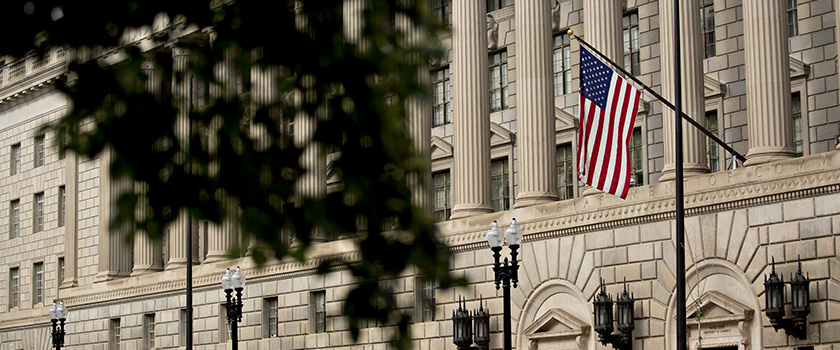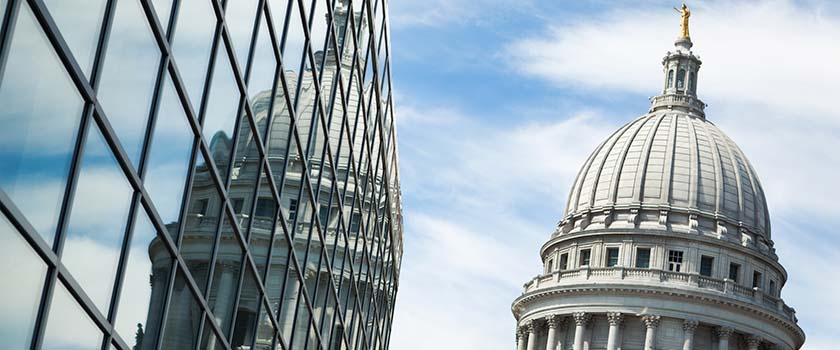China’s economy decelerated in Q2-23, led by a sequential decline in manufacturing and investment. Services continue to expand at a slower pace. Below potential growth is resulting in rising unemployment in April and May.
Key takeaways
-
Against this backdrop, disinflationary pressures have started to build, especially for upstream prices. This justified the People’s Bank of China (PBOC) rate cut on June 20. Additional fiscal support measures were also announced.
- Market expectations of additional stimulus have been met with scepticism. Investors are concerned that China may have entered a liquidity trap or is experiencing a balance sheet recession. These fears might be overstated.
- Chinese policymakers are going about tackling the different factors underpinning weak sentiment. Given the scattered nature of this support, it may take time for upside pressures on domestic asset prices to build and the CNY to stabilise.
PBOC delivers much-needed policy stimulus to stem sequential slowdown
Economic activity has decelerated noticeably in Q2-23. Furthermore, the sequential slowdown is most prominent across manufacturing and investment (i.e. the supply side). Industrial production declined to 3.5% y/y in May, down from 5.6% y/y in April and reversing half of the gains from Q1-23. Moreover, Fixed Asset Investments (FAI) slowed to 4.0% YTD y/y in May, down from 4.7% YTD y/y in April and reaching the weakest level since 2021. Although both gauges remain expansionary, the devil is in the details. Upon closer inspection, the private sector seems to be faring much worse than headline numbers suggest. Excluding State-Owned Enterprises (SOEs), private FAI came in notably weaker at 0.4% YTD y/y (vs SOEs 9.4% YTD y/y). We observe a similar trend across industrial production, with the private sector contracting by -0.1% y/y (vs SOEs 8.4% y/y). In other words, policymakers have instructed SOEs to shore up production and capital expenditure (CAPEX) to support growth, but the situation on the ground for private companies could be way worse. Consumption continues to be the bright spot in what looks set to become another challenging year for the Chinese economy, but we are also observing signs of deceleration on the demand front. Retail sales declined to 12.7% y/y in May, down from a high base of 18.4% y/y in April. On a two-year adjusted basis, which excludes base effects from the Shanghai lockdown in 2022, retail sales remained below their 10-year average of 7.6% y/y at 5.2% y/y.
Most importantly, the recovery in domestic consumption is not broad-based. Most of it has been driven by pent-up demand for services, following months of local lockdowns. For example, catering services expanded 35.1% y/y in May, down from 43.8% in April. Clothing – also closely linked to services – declined to 21.2% y/y in May, this was from a very high 39.9% y/y in April and following strong Q1-23 performance. We are also seeing some upside in the automotive sector (24.2% y/y), as demand remains resilient due to aggressive subsidies to support the sector (0.4% of GDP). As these tailwinds begin to normalise, domestic consumers will have to grapple with weak expectations and mounting economic uncertainties.
Against this backdrop, disinflationary pressures have started to build. China’s Consumer Price Index (CPI) may have bottomed in April, increasing to 0.2% y/y in May (prior: 0.1% y/y). However, the Producer Price Index (PPI) contracted to -4.6% y/y in May (prior: -3.6% y/y), denoting falling factory prices and excess capacity across multiple sectors. Although subdued inflation is good news for consumption, excessive deflation is also problematic, as it entails smaller profits for companies and slower job creation. That narrative is problematic and significantly reinforces the case for PBOC easing going forward.
On June 20, the PBOC delivered a 10 bp rate cut to its 1Y and 5Y Loan Prime Rates (LPR). This was the first cut in 10 months. We had expected asymmetric 5 bp and 15 bp rate cuts to the 1Y and 5Y LPR respectively. For instance, on August 15, the PBOC lowered the 7-day Reverse Repo Rate and 1Y Medium-term Lending Facility (MLF) by 10 bp. This decision paved the way for a 5 and 15 bp asymmetric rate cut to the 1Y and 5Y LPR the following week. The 5Y LPR is used to price mortgages, so most of the firepower had previously concentrated here. However, the decision to deliver a symmetric cut instead is a testament to how severe the sequential slowdown has been across manufacturing and investment in Q2-23. In other words, this is no longer only an issue of subdued housing demand. Therefore, the policy mix must be calibrated differently.
Neither liquidity trap nor balance sheet recession
The PBOC cited the need to maintain “appropriate interbank liquidity” when justifying its rate cut. However, we think this is not the issue. In fact, there is ample liquidity in the interbank system, with SHIBOR rates declining rapidly due to weaker demand for loans. Our proprietary domestic financial conditions index also points to very accommodative conditions, around one standard deviation below the 10-year mean. The move is mostly symbolic, hinting that more support measures may be on their way, and is almost entirely aimed at improving sentiment.
Weak domestic sentiment has prompted many international investors to become concerned that China may be experiencing a “liquidity trap”. The term, which was first coined by John Maynard Keynes in 1936, is used to describe an adverse economic situation that can occur when consumers and investors choose to hoard cash in checking and savings accounts rather than spending or investing it, even when interest rates are low or close to zero. This stymes efforts by policymakers to stimulate economic growth, as the main tool used by the central bank is less effective in these cases. In other words, cutting interest rates would be like “pushing on a string”.
Some parallels are noteworthy. Chinese households are sitting on a sizeable pile of excess savings, following many months of pandemic lockdowns. We estimate this pool of excess savings (defined as the difference between household new deposits and new loans) to be around USD 175 Bn or approximately 1% of nominal GDP. Even then, and despite the government’s best efforts, many households are choosing to use the “war chest” to pay back mortgages or are keeping them in savings accounts to prepare for a rainy day. For example, although the PBOC has cut the 5Y LPR by 350 bp since January 2022, mortgages declined by -22% y/y during the same period.
But there is one important caveat – interest rates are not low. On the contrary, interest rates have increased in real terms, owing to a rapid decline in inflation and very prudent support from the PBOC, at least until now. Real interest rates averaged 2.6% in May, exceeding levels not seen since February 2020. This is also much higher than in the US, where real interest rates are negative around -1.1%. This has increased the cost of servicing debt, explaining why many households may have chosen to deploy pandemic surpluses to deleverage their exposure to the distressed sector. Structural factors may also have played a role. For example, mortgage rates vary across cities and are adjusted on a yearly basis. That would have left homeowners that bought during the peak in 2021 paying higher interest rates for an entire 12 months, meaning early settlement may well have resulted in smaller interest repayments over the course of the loan.
A better comparison is the possibility that China has entered a balance sheet recession. The term was first coined by Nomura Research Institute’s Chief Economist Richard Koo in the mid-2000s. Koo identified that Japan’s woes could be traced back to issues with household “balance sheets” and observed similarities in the US market after the sub-prime mortgage crisis. The term derives from an accounting equation which states that assets must always equal the sum of liabilities plus equity. If asset prices fall below the value of the debt incurred to purchase them, households would be left insolvent (negative equity on loans). However, investors should not extrapolate Japan’s past experiences onto China so lightly.
Although China’s debt-to-GDP ratio is admittedly high, reaching 336% in 2022, most of this is concentrated in the corporate sector (224%). In contrast, household debt is not particularly high (62% vs 66% in the US and 68% in Japan). Chinese households also have saving rates which are higher than global levels (46% vs 28% in Japan and 19% in the US). Households remain net savers, while the corporate sector continues to be a net borrower – ironically this was Koo’s preferred equilibrium. In contrast, households were net borrowers in Japan in the 1990s while Japanese corporates continue to hoard cash to this day.
The answer is more likely confidence. High consumer saving levels, often spurred by the belief that a negative economic event is on the horizon, can cause issues in monetary policy transmission. Some reasons include:
- Financial risks: The mandate of the PBOC was adjusted in March, following the creation of the National Financial Regulatory Administration (NFRA). In addition to stabilising inflation and growth, the PBOC will focus on reducing financial fragilities. It will be a delicate balance: too much stimulus could aggravate existing risks, reversing years of painful, policy-driven deleveraging. However, too little support could exacerbate deflationary pressures. Additionally, PBOC Governor Yi Gang is expected to step down, paving the way for Pan Gongsheng, who was nominated Party Secretary on July 1, to take the helm. Leadership and reporting line changes could result in a slower reaction function, which doesn’t help to assuage markets.
- Structural factors: Domestic sentiment has been weighed by the sluggish recovery in the real estate sector. At its peak, the real estate sector accounted for approximately 30% of GDP both directly and indirectly. However, home prices in second and third tier cities have contracted for over a year. In the absence of stronger policy support, weaker activity is fuelling youth unemployment (16-24), which reached a record high of 20.8% in May. That erodes consumer confidence, especially amongst the younger urban population, which have a higher propensity to consume.
- Lacklustre alternatives: Households could have assumed that there is limited upside in the real estate sector in the years ahead. After all, “houses are to live in, not to speculate”. Moreover, Chinese equities are down -3.0% YTD; while bonds continue to face headwinds surrounding an impending restructuring of weaker real estate developers. Wealth management products are also off-limits, following several corruption scandals in 2022. Under these circumstances, paying off mortgages might seem like the best option to many. In other words, animal spirits remain latent but don’t have an appropriate channel of expression.
Implications for investors – expect more targeted support
China is technically not in a balance sheet recession or a liquidity trap. The sequential slowdown in Q2-23 was not driven by fluctuations in the credit cycle. Moreover, households remain solvent. In our opinion, this is predominantly an issue of weak sentiment, aggravated by a sequential slowdown in Q2-23. The government will likely tackle these issues separately.
Firstly, real interest rates remain too high. These can be lowered through a combination of rate cuts and measures to boost inflation. Another rate cut in Q3-23 is less likely, although not impossible. We think the PBOC will likely consider an additional 50-75 bp in Reserve Requirement Ratio (RRR) cuts as well as continued support via liquidity injections instead. Balance sheet expansion may also play a role. The PBOC’s balance sheet has contracted since the start of 2023, exerting pressure on domestic asset prices. But there is ample room for PBOC to use its balance sheet to support key sectors. Government debt amounts to 3.8% of PBOC’s balance sheet vs 55% for the US Fed and 80% for Bank of Japan. Previous examples of this include the Pledged Supplementary Lending (PSL) programme of 2016 and Shantytown Renovation Programme of 2018.
Given the targeted nature of monetary support, a broad package of fiscal measures will likely be considered in tandem. Arguably, this has already started. The State Council announced plans to develop Electric Vehicle (EV) charging infrastructure and is also offering CNY 100k (USD 13.5k) tax exemptions for EV purchases until 2025, and CNY 50k (USD 6.8k) until 2027. The central government is also mulling more measures to support the real estate sector. The downturn in China’s housing sector has its origins in stringent policies to force deleveraging amongst real estate developers. These include the “three red lines” policy, which limits real estate developer’s ability to access financing unless they met certain macroprudential criteria. Reversing some of these would help to support the sector. Once again, this has already started. For example, the loan-to-value ratio has been raised in several second-tier cities, making it easier for first time homeowners to access housing and reducing the need to save. In addition, allowing some asset price appreciation in first-tier cities would help to boost construction activity and absorb surplus labour.
The private sector can also play a key role in promoting job creation. Contrary to popular belief, 80% of jobs in China are in the private sector. By reversing or pausing the regulatory campaign, the central government would provide some breathing room for private companies. Indirectly, this would also help with animal spirits. There has been a gaping disparity between money growth and domestic equity performance since 2020. This gap can be best explained by the introduction of the regulatory campaign on the tech sector. Financial reforms, ranging from changes to IPO rules to Alibaba’s restructuring, can also help to provide an alternative investment option for domestic households.
Lastly, the CNY is another tool in the PBOC’s arsenal. Specifically, we believe it could be advantageous for the CNY to weaken in trade-weighted-terms to prevent further erosion in China’s terms of trade, within a reasonable range. Policy rate differentials with the US also point in this direction. With that being said, excessive devaluation is also not desirable, as this would fuel portfolio outflows and reduce PBOC’s ability to deploy firepower.









